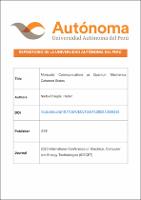| dc.contributor.author | Nieto-Chaupis, Huber | |
| dc.date.accessioned | 2024-04-05T14:41:01Z | |
| dc.date.available | 2024-04-05T14:41:01Z | |
| dc.date.issued | 2023 | |
| dc.identifier.uri | https://hdl.handle.net/20.500.13067/3089 | |
| dc.description.abstract | In most cases, molecular communication might require of wavefront-like dynamics that maximizes the arrival of drug into a target. Thus, while the technique of drug delivery can partially see as a stochastic dynamics, one might to expect that certainly probabilistic theories can be applied successfully. In this letter, the theory of quantum mechanics coherent states is used to calculate the success probability of engineered cell communications. The resulting probabilities are compared to the ones obtained without probabilistic approaches, showing that the quantum theory turns out to be precise, fact that would open space to speculate that molecular communication can be inherently described by Quantum coherent states. | es_PE |
| dc.format | application/pdf | es_PE |
| dc.language.iso | eng | es_PE |
| dc.publisher | IEEE | es_PE |
| dc.rights | info:eu-repo/semantics/restrictedAccess | es_PE |
| dc.rights.uri | https://creativecommons.org/licenses/by-nc-nd/4.0/ | es_PE |
| dc.subject | Molecular communications | es_PE |
| dc.subject | Quantum coher-ence | es_PE |
| dc.subject | Arbitrium | es_PE |
| dc.title | Molecular Communications as Quantum Mechanics Coherent States | es_PE |
| dc.type | info:eu-repo/semantics/article | es_PE |
| dc.identifier.journal | 2023 International Conference on Electrical, Computer and Energy Technologies (ICECET) | es_PE |
| dc.identifier.doi | https://doi.org/10.1109/ICECET58911.2023.10389333 | es_PE |
| dc.subject.ocde | https://purl.org/pe-repo/ocde/ford#2.02.04 | es_PE |


